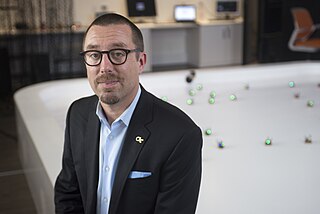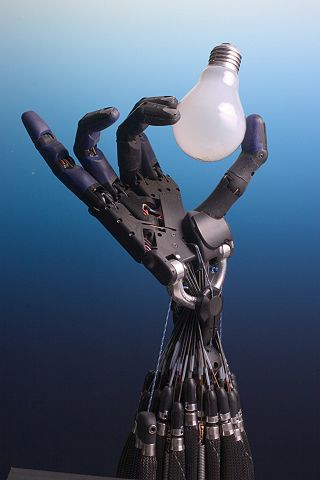Related Research Articles

Automation describes a wide range of technologies that reduce human intervention in processes, mainly by predetermining decision criteria, subprocess relationships, and related actions, as well as embodying those predeterminations in machines. Automation has been achieved by various means including mechanical, hydraulic, pneumatic, electrical, electronic devices, and computers, usually in combination. Complicated systems, such as modern factories, airplanes, and ships typically use combinations of all of these techniques. The benefit of automation includes labor savings, reducing waste, savings in electricity costs, savings in material costs, and improvements to quality, accuracy, and precision.
A Bachelor of Engineering or Bachelor of Science in Engineering or AMIE (Sec:A&B) is an undergraduate academic degree awarded to a college graduate majoring in an engineering discipline at a higher education institution.

Food engineering is a scientific, academic, and professional field that interprets and applies principles of engineering, science, and mathematics to food manufacturing and operations, including the processing, production, handling, storage, conservation, control, packaging and distribution of food products. Given its reliance on food science and broader engineering disciplines such as electrical, mechanical, civil, chemical, industrial and agricultural engineering, food engineering is considered a multidisciplinary and narrow field.

Robot welding is the use of mechanized programmable tools (robots), which completely automate a welding process by both performing the weld and handling the part. Processes such as gas metal arc welding, while often automated, are not necessarily equivalent to robot welding, since a human operator sometimes prepares the materials to be welded. Robot welding is commonly used for resistance spot welding and arc welding in high production applications, such as the automotive industry.
The Aerospace, Transportation and Advanced Systems Laboratory (ATAS) is one of eight labs in the Georgia Tech Research Institute and one of three labs under the Sensors and Intelligent Systems directorate. ATAS develops advanced systems concepts and performs research related to aerospace systems, power and energy systems, threat systems, intelligent autonomous systems, and systems engineering methodologies. The lab also develops advanced technologies and performs research in a range of areas relevant to aerospace and ground transportation as well as to national defense.
The Health and Environmental Systems Laboratory (HESL) was one of eight labs in the Georgia Tech Research Institute. In mid-2006, it was disbanded, and the staff were transferred to other parts of GTRI. ELSYS, the largest lab within GTRI, received most of the personnel.

Laboratory automation is a multi-disciplinary strategy to research, develop, optimize and capitalize on technologies in the laboratory that enable new and improved processes. Laboratory automation professionals are academic, commercial and government researchers, scientists and engineers who conduct research and develop new technologies to increase productivity, elevate experimental data quality, reduce lab process cycle times, or enable experimentation that otherwise would be impossible.
The Industrial Technology Research Institute is a technology research and development institution in Taiwan. It was founded in 1973 and is headquartered in Hsinchu City, Taiwan, with branch offices in the U.S., Europe, and Japan.

Manufacturing engineering or production engineering is a branch of professional engineering that shares many common concepts and ideas with other fields of engineering such as mechanical, chemical, electrical, and industrial engineering. Manufacturing engineering requires the ability to plan the practices of manufacturing; to research and to develop tools, processes, machines, and equipment; and to integrate the facilities and systems for producing quality products with the optimum expenditure of capital.

Magnus B. Egerstedt is a Swedish-American roboticist who is the Dean of the Henry Samueli School of Engineering at the University of California, Irvine. He was formerly the Steve C. Chaddick School Chair and Professor at the School of Electrical and Computer Engineering, Georgia Institute of Technology.
Cyber-Physical Systems (CPS) are integrations of computation with physical processes. In cyber-physical systems, physical and software components are deeply intertwined, able to operate on different spatial and temporal scales, exhibit multiple and distinct behavioral modalities, and interact with each other in ways that change with context. CPS involves transdisciplinary approaches, merging theory of cybernetics, mechatronics, design and process science. The process control is often referred to as embedded systems. In embedded systems, the emphasis tends to be more on the computational elements, and less on an intense link between the computational and physical elements. CPS is also similar to the Internet of Things (IoT), sharing the same basic architecture; nevertheless, CPS presents a higher combination and coordination between physical and computational elements.

Robotics is the interdisciplinary study and practice of the design, construction, operation, and use of robots.

A driverless tractor is an autonomous farm vehicle that delivers a high tractive effort at slow speeds for the purposes of tillage and other agricultural tasks. It is considered driverless because it operates without the presence of a human inside the tractor itself. Like other unmanned ground vehicles, they are programmed to independently observe their position, decide speed, and avoid obstacles such as people, animals, or objects in the field while performing their task. The various driverless tractors are split into full autonomous technology and supervised autonomy. The idea of the driverless tractor appears as early as 1940, but the concept has significantly evolved in the last few years. The tractors use GPS and other wireless technologies to farm land without requiring a driver. They operate simply with the aid of a supervisor monitoring the progress at a control station or with a manned tractor in lead.
Peter Corke is an Australian roboticist known for his work on Visual Servoing, field robotics, online education, the online Robot Academy and the Robotics Toolbox and Machine Vision Toolbox for MATLAB. He is currently director of the Australian Research Council Centre of Excellence for Robotic Vision, and a Distinguished Professor of Robotic Vision at Queensland University of Technology. His research is concerned with robotic vision, flying robots and farming robots.
Instrumentation and control engineering (ICE) is a branch of engineering that studies the measurement and control of process variables, and the design and implementation of systems that incorporate them. Process variables include pressure, temperature, humidity, flow, pH, force and speed.
Industrial and production engineering (IPE) is an interdisciplinary engineering discipline that includes manufacturing technology, engineering sciences, management science, and optimization of complex processes, systems, or organizations. It is concerned with the understanding and application of engineering procedures in manufacturing processes and production methods. Industrial engineering dates back all the way to the industrial revolution, initiated in 1700s by Sir Adam Smith, Henry Ford, Eli Whitney, Frank Gilbreth and Lilian Gilbreth, Henry Gantt, F.W. Taylor, etc. After the 1970s, industrial and production engineering developed worldwide and started to widely use automation and robotics. Industrial and production engineering includes three areas: Mechanical engineering, industrial engineering, and management science.
The Food Processing Technology Building is a Georgia Institute of Technology and Georgia Tech Research Institute facility. It houses the Food Processing Technology Division of GTRI, which includes the Agricultural Technology Research Program (ATRP) and Georgia’s Traditional Industries Program for Food Processing. It opened on March 1, 2005, and was dedicated on May 19, 2005.

Smart manufacturing is a broad category of manufacturing that employs computer-integrated manufacturing, high levels of adaptability and rapid design changes, digital information technology, and more flexible technical workforce training. Other goals sometimes include fast changes in production levels based on demand, optimization of the supply chain, efficient production and recyclability. In this concept, as smart factory has interoperable systems, multi-scale dynamic modelling and simulation, intelligent automation, strong cyber security, and networked sensors.

A self-driving truck, also known as an autonomous truck or robo-truck, is an application of self-driving technology aiming to create trucks that can operate without human input. Alongside light, medium, and heavy-duty trucks, many companies are developing self-driving technology in semi trucks to automate highway driving in the delivery process.

The impact of artificial intelligence on workers includes both applications to improve worker safety and health, and potential hazards that must be controlled.
References
- ↑ "Technology for the poultry industry". GTRI 75 Years. Georgia Tech Research Institute. Retrieved 2011-04-13.
- ↑ "Agricultural Technology Research Program Brochure" (PDF). Agricultural Technology Research Program. Archived from the original (PDF) on 2011-07-19. Retrieved 2011-04-06.
- ↑ "Developing a Washable Robot for Poultry Processing". Georgia Tech Research Institute. Retrieved 2011-04-06.
- ↑ "Washdown-Ready Robot Undergoes In-Plant Tests". TheMeatSite. August 2009. Retrieved 2011-04-13.
- ↑ "Cone line screening: Improved yield, no bones about it!". WorldPoultry.net. 2011-04-05. Archived from the original on 2011-07-22. Retrieved 2011-04-13.
- ↑ "Perfect Buns: Imaging System Controls Baking Process on Production Line to Improve Sandwich Bun Quality". Georgia Tech Research Institute. Retrieved 2011-04-06.
- ↑ "Energy Efficiency in Poultry Processing" (PDF). International Poultry Exposition Sustainability Summit. U.S. Poultry & Egg Association. Jan 2011. Retrieved 2011-04-13.
- ↑ "Byproduct Applications: Turning Poultry Waste into Fuel". Georgia Tech Research News (Press release). Georgia Institute of Technology. 2009-05-26. Retrieved 2011-04-15.
- ↑ "Field Trials Demonstrate Potential Value of Repetitive Motion Exposure Assessment Tool". Georgia Tech Research Institute. Retrieved 2011-04-06.
- ↑ "Prototype Sensor under Development to Automatically Detect Chlorine Levels in Poultry Chiller Water". Georgia Tech Research Institute. Retrieved 2011-04-06.
- 1 2 "National Safety Conference for the Poultry Industry". Georgia Tech Research Institute. Archived from the original on 2011-08-25. Retrieved 2011-04-15.